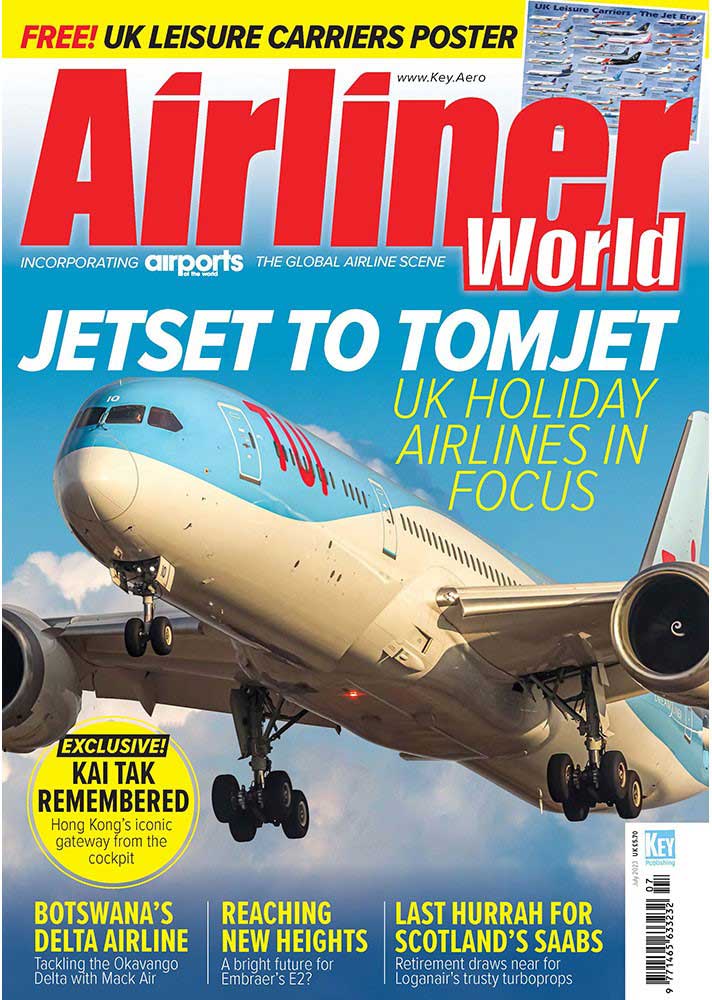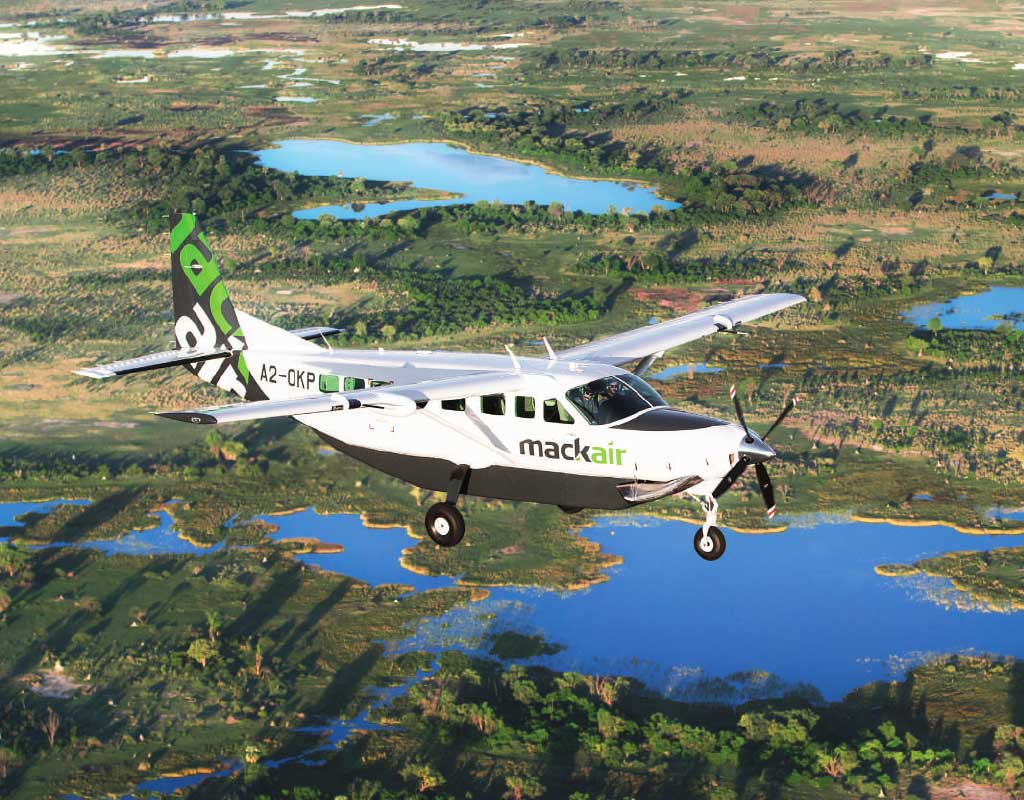Mack Air was launched in 1994 in a shack with a single fivepassenger Cessna 206 Stationair. It has grown to become one of Southern Africa’s major air charter companies.
Andreas Spaeth travels to the African wilderness to find out how Mack Air operates, with extraordinary attention to detail, in and around the vast Okavango Delta.
The mighty Okavango Delta lies in the heart of Africa and is a dream destination for many travellers. These swampy wetlands offer one of the continent’s most stunning wildlife and nature experiences and are rated by UNESCO as a World Heritage Site. Visitor access is restricted to guests of one of the 74 upscale lodges located around the delta, spreading across more than 6,000 square miles in the north of Botswana. In total, there are just 595 rooms in the area, and few are available for less than US$1,000 per night. A princely sum, but one that is inclusive of high-end accommodation, gourmet meals, game drives, and experienced wildlife guides.
Around 100,000 people visit the delta each year, 80% of whom are from North America. All tourists fly to their lodges, which often have no other practical form of access, even for logistics. Depending on the season and water levels in the delta, goods can sometimes be delivered on 4×4 trucks, but this is typically over unpaved sand tracks, or on barges. You have probably never heard of Botswana’s Maun Airport, but it handled 240,000 passengers annually before the pandemic. “In peak season from June to August, Maun becomes Africa’s second busiest airport in terms of flight movements after Johannesburg,” noted Michael Weyl, owner and CEO of Mack Air, the largest airline in Botswana by fleet size.
A short history
Mack Air was founded in 1994 by Okavango enthusiasts Lara and Stuart Mackay, hence the name. Operations started in a rustic shack in Maun with a single five-passenger Cessna 206 Stationair. Fast forward a couple of decades and three guys, originally from Zimbabwe, took over the business. They’ve finessed it into a jewel of airline excellence in a remote corner of the world not exactly famed for sleek and successful carriers.
One of the trio invested a good chunk of his wealth, accumulated in the financial sector, building a remarkable fleet. Mack Air ordered its first batch of ten factory-fresh Cessna 208 Grand Caravan EXs in 2017. This most modern version of the 12-seat classic propliner is much loved in areas such as the African bush.
Before long, Mack Air was given the option to buy another tranche of type and fortunately it did so, as during the pandemic manufacturer Textron imposed a hiatus on production. This pause in output has made Mack Air’s 18 Grand Caravan EXs even more valuable. “Their market price has hit around US$3m a piece,” revealed Weyl.
His fleet is the youngest of any airline in its category on the entire African continent. One more superlative applies to Maun airport in this respect: “Nowhere in the world are there more Grand Caravans based than here; in the peak season we have about 35 stationed in Maun,” estimated Paul Murdock, a New Zealander and veteran pilot flying for Mack Air.

Michael Weyl is the owner and chief executive of Mack Air.
Unique position
There are other local companies operating the type to connect lodges in the delta to its main gateway airport, but most of them are affiliated with or run by lodge operators themselves, meaning there is little perceivable airline brand. Mack Air is quite the opposite and competing successfully for contracts to fly passengers and goods.
Unlike in usual airline markets, it’s not the passenger making bookings here. “Our flights are booked by the lodges after they’ve received a guest’s booking,” explained Weyl. “With remote lodges and limited rooms, the risk of passengers getting stranded in the wilderness would be too big otherwise.”
With such a captive audience, it has become a rather lucrative market for Mack Air, especially as it is allowed to charge in US dollars, with set airfares between $185 to $320 per leg. The exact price depends on distance and how much business a specific lodge generates for the company, but even a modest ten-minute hop is charged with at least $185, generating yield which would make much bigger carriers envious. With this in mind, it is little wonder that Mack Air has been profitable in every year since 1994, with the obvious exception of 2020. Overall, this is quite an achievement for an airline whose sectors often take just ten minutes in the air, bridging distances of less than 30 miles that couldn’t be easily connected otherwise.
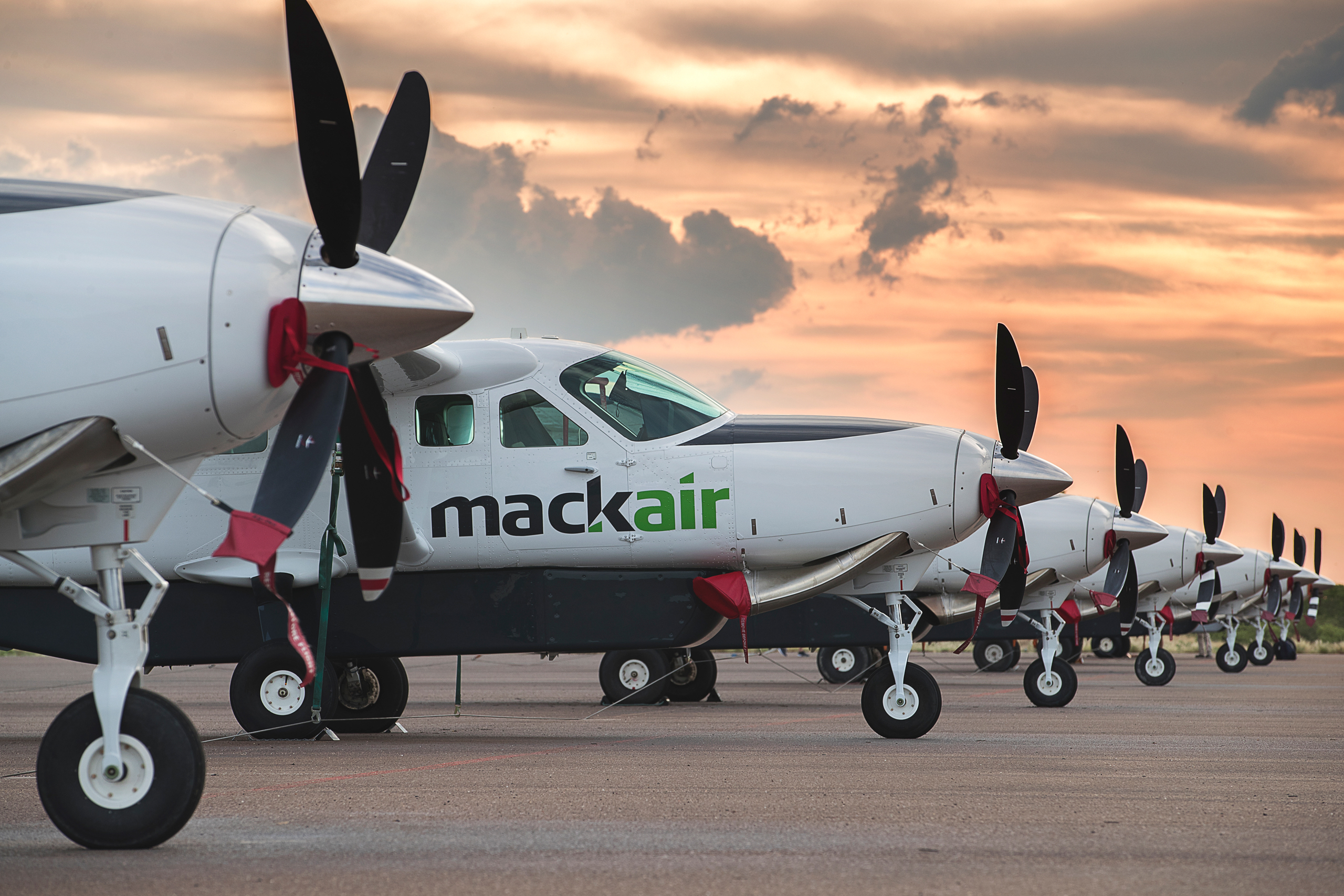
Right on schedule
Mack Air has recently been awarded a licence to fly scheduled services as the first private airline in Botswana, the other being state-run Air Botswana (currently flying two ATR-72s and one Embraer E170).
Mack Air has daily scheduled runs between Maun and Kasane (both primary safari destinations in Botswana) and also between Victoria Falls in Zimbabwe and Maun, another top tourist spot in the region. Mack Air is also in the process of establishing scheduled operations in Zimbabwe with two dedicated Grand Caravans registered in the country.
“Mack Air is registered now as a scheduled carrier, that’s massive out here, and it was a major undertaking, nobody else managed to do that yet,” says not the company boss, but newly hired pilot Samantha Steel. The 35-year old South African has flown in the delta before and is now one of relatively few expats flying for Mack Air. Up to 80% of the current 24 flight crew are already local, however the airline is still short of pilots as it needs a total of 32 to operate its current fleet. Besides the Grand Caravans and the last GippsAero GA8 Airvan (of formerly seven examples), Mack Air’s fleet also comprises a pair of Cessna 206s and 210s.
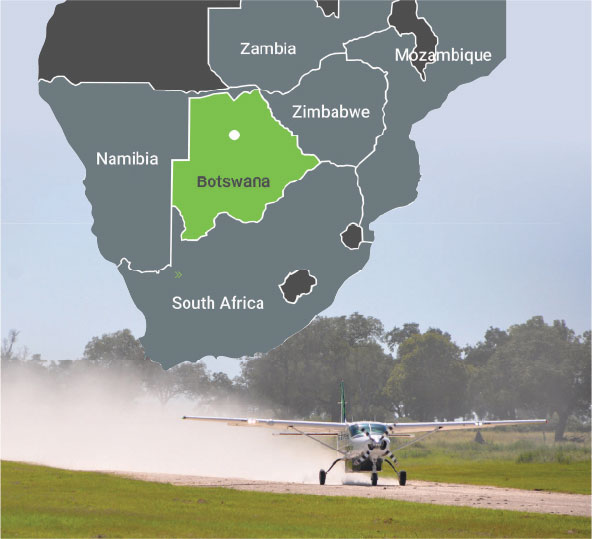
Map: The airline is headquartered at Maun Airport in central Botswana; an airfield which makes an excellent staging post for flights into the delta.
Image: Mack Air is primarily a non-scheduled air charter service, transporting clients in and around the Okavango Delta.
Proving the pilots
Veteran Mack Air pilot Paul Murdock is currently flying from the right seat, instructing and supervising young local recruits. He is ensuring they perform to the high standards the airline sets, before being allowed to fly the Cessna Caravans on their own in single pilot operations.
“Pilot supply is a sore question,” he admits. “The Botswana government produces pilots, but they are mostly low-hour. Many of them that we take on, we have to push to 800 hours flying with an instructor on the right seat before they can fly by themselves – or when they are ready,” says the New Zealander, himself having logged more than 5,000 hours.
“We need experienced command captains to fly with the junior guys, and to do that, we need work permits as they are foreigners, and that’s a sensitive subject as well. But we don’t accept putting a substandard pilot in the cockpit, they have to meet our minimum requirements, meaning you are just short of being excellent,” insisted the 61-year old.
The hurdles this little airline installs before entrusting an aircraft full of passengers to a single pilot in a rugged environment are on par with big carriers, and the equipment used is no less impressive: “We just procured a virtual reality simulator and bought a psychometric testing programme, so we can evaluate a pilot’s skills on the ground before actually sending an aircraft in the air,” reported Weyl.
For pilots from near and far, flying in the Okavango Delta is a dream come true with unrivalled opportunities. Steel packed up her car in Cape Town and drove to Maun in 24 hours with a night stop, when she was offered a job here. “This is one of the few places where you can land in a reserve that is not fenced in; the delta is the last of its kind in the world and you can see it from space.”
Meanwhile, chief pilot Tafadzwa Mugoni is from Zimbabwe and no less taken by this kind of work: “I really enjoy flying in Botswana, it’s really like no place else. We fly very short sectors and [the] flying is very fastpaced, it helps a lot with your flying skills.” Schedules are not fixed, but rather put together by the scheduling team in Mack Air’s offices in Maun every afternoon for the next day.
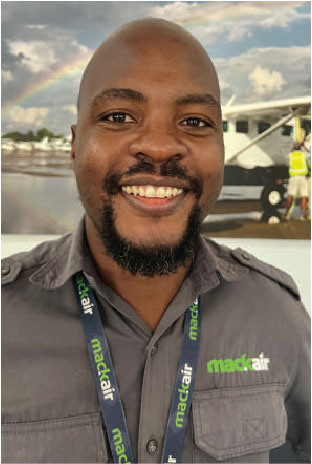
Mack Air’s chiefpilot is TafadzwaMugoni fromZimbabwe
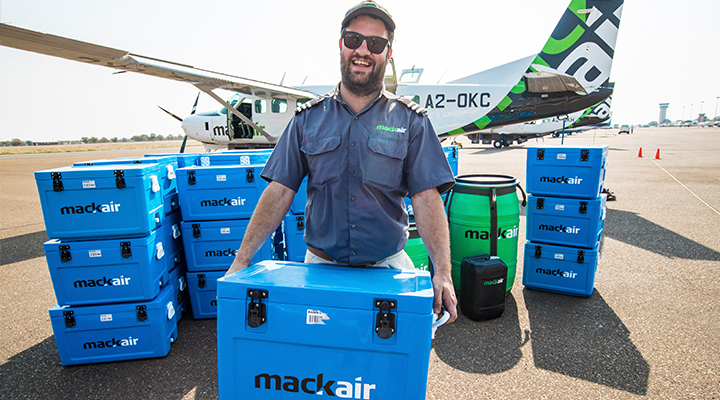
As well as transporting passengers and camp staff , the airline also acts as an important freight provider for perishable products at the high-end camps
Caravan quirks
Murdock has high praise for Mack Air’s mainstay type: “To me the Cessna Caravan is the quintessential bush aircraft, its perfect for the fields we operate out of; it’s got high wings, so we have a good field of view. When they upgraded to the bigger engines and put the STOL [short take-off and landing] kits on, we now can take more weight, up to 1.4 tons of freight.”
Cargo is an important source of income for Mack Air – with many lodges relying on their weekly all-freight charter flight operated by the airline, supplying the lodges with perishables and fresh produce urgently needed to cater for their discerning guests.
In January 2023, US manufacturer Textron delivered the 3,000th Grand Caravan. The last new example for Mack Air came just before the pandemic following a gruelling 50+ hour delivery journey from the factory in Wichita, Kansas to Maun. The EX is equipped with the more powerful Pratt & Whitney Canada PT6A-140 delivering 867hp, enabling a climb rate 38% faster.
Before he headed off for another sortie, Murdock summed up the status quo: “In the old days, things were much more relaxed here, similar to Alaskan bush flying that now has become very regulated, and it’s good it has gone that way. We made it much, much safer than before – though it was very safe before – we’ve mitigated everything we possibly can.”
Wildlife wonders
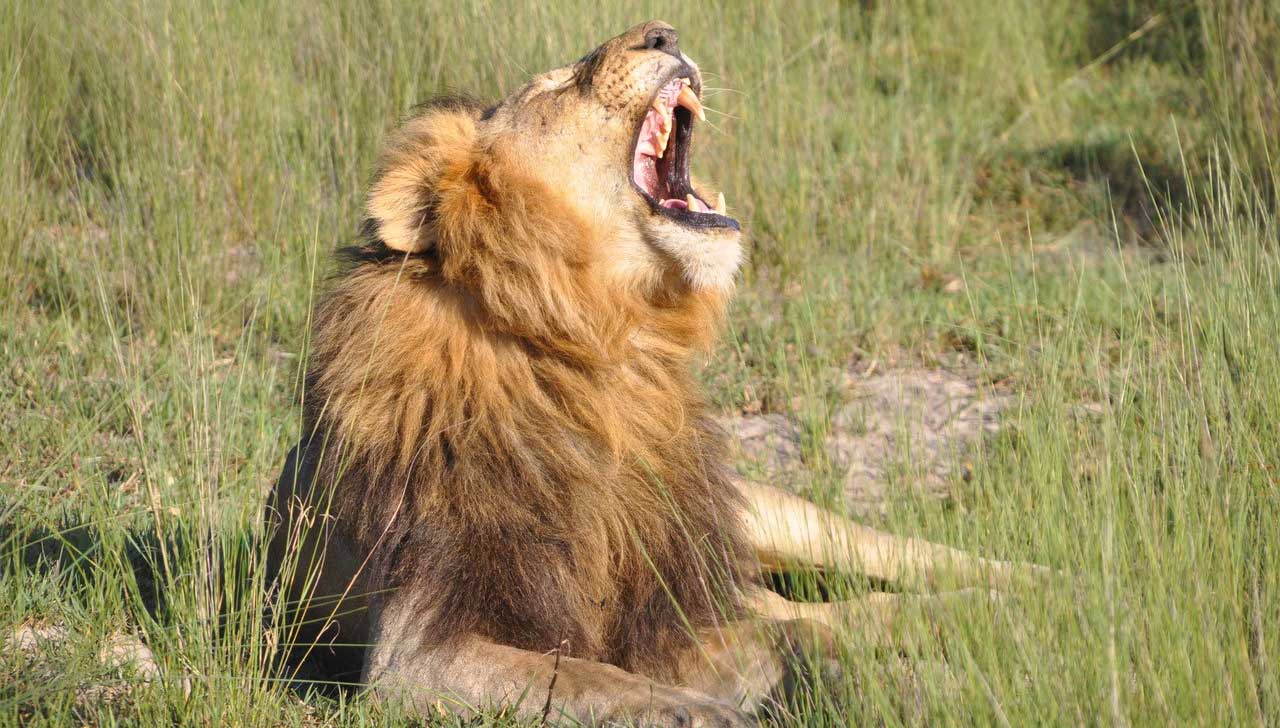
“A pride of five lions appeared in front of me on short finals, just at the threshold where I was going to land, their tummies were all massive after feeding, so they didn’t want to move…”
“It is very interesting to see the changing landscape in the delta in different seasons. You are always on safari here, and often before landing, you have ticked off the list of the ‘Big Five’ [animals] already,” delighted Mugoni. Steel continued: “This is one of the few places in the world where you have as many take-offs and landings as we do, there are days we do 12 to 14 short hops between sunrise and sunset, you basically stay in the critical phases of flight almost the entire day.”
Weyl revealed that on top of all this excitement is a unique perk for these intrepid aviators: “Our pilots spend the night out in camps maybe twice a week, and crews basically stay in guest rooms. We have an agreement where we fly lodge management for free if the pilot night-stops for free, we certainly wouldn’t pay thousands of dollars!”
For younger pilots or those without family in Maun, this is a precious treat they enjoy as often as schedules allow. For the airline it’s also much more efficient than having them fly empty legs back, and maybe outbound again the next morning, to pick-up early passengers.
Long-haul links?
From a passenger perspective, it all starts when they exit the arrivals area in Maun, usually fresh off a flight from South Africa. Besides the Victoria Falls flights from Mack Air, the only other international services are from Johannesburg (currently on Airlink, Air Botswana and Cem Air) plus Cape Town (Airlink). “We are looking to expand our accessibility and we are in talks with a European airline [about] flying widebodies directly into Maun from the third quarter of 2023. They would use us as a feeder airline,” revealed Weyl.
“Private Boeing 757s, Airbus A321s and US Air Force C-17s come in here all the time,” he stressed, so the airport has the theoretical capability to handle something a little larger. It is believed A330s and A340s of German holiday airline Eurowings Discover and Swiss carrier Edelweiss are prime candidates for direct services.
The density of the network of airstrips in a confined area is stunning. “There are 30 airfields in the delta within a 50-nautical mile range; I recently counted them. Now that is intimate flying,” says Alexander Jones, a 30-year-old pilot from Botswana’s capital Gaborone. The country, on the other hand, offers just the opposite – Botswana is one of the least populated countries in the world, with more than 70% of its landmass covered by the enormous Kalahari Desert. Roughly the size of France, the nation is home to just 2.3 million people as well as 130,000+ elephants, one of the highest concentrations on the planet.
While there isn’t formal air traffic control in the bush, that doesn’t mean pilots lack communication options. “We have an ATC-controlled zone 20 miles around Maun, but anything beyond that we are just chatting to each other. We can see other traffic on our screens, the Caravans even come with TCAS [traffic collision avoidance system],” said Steel.
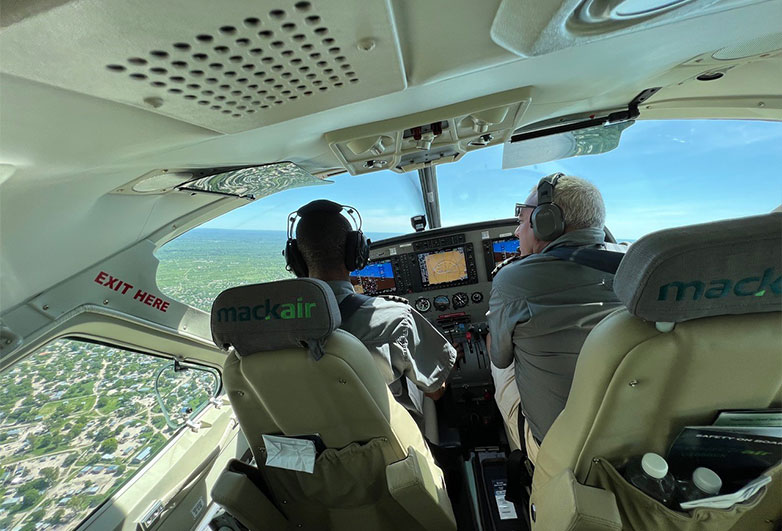
Obi (left) and Paul pictured on the flight deck for Airliner World’s trip on board A2-OKL (c/n 208B5467)
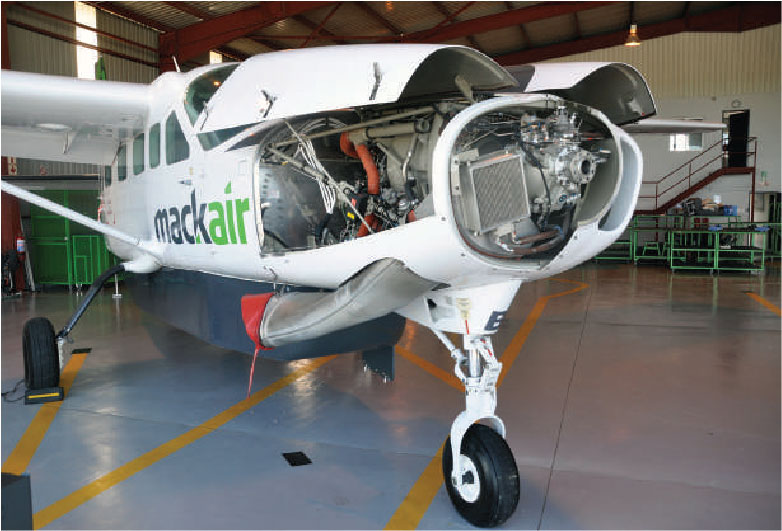
The powerful PT6A-140 engines generate 867
horsepower for high efficiency and a dependable payload
performance.
Getting on board
After a fantastic overview of operations, it was time to get on board for ourselves. For our trip, Paul Murdock is flying with a young pilot from Botswana named Obi. The flight plan for the day calls for four short legs in the morning and a longer return in the afternoon. Our aircraft, A2-OKL (c/n 208B5467) stands in line with half-a-dozen other Mack Air Grand Caravans, all sporting their sleek tail design next to each other.
On board, there are a dozen comfortable seats, comprising four double benches and four singles, all upholstered in beige leather. There’s even air conditioning, a big plus in the oppressive heat, which helps to offer a more comfortable ride than might be expected in the African wilderness. From the front-row seats, passengers get a great view of the modern glass cockpit with its state-of-the-art Garmin G1000 Nxi integrated flight deck avionics.
The first leg is the 22.5nm hop from Maun to Stanleys, with a scheduled flight time of ten minutes (this actually takes 16 minutes in the end for some extra sightseeing). “The same distance by car would take six to eight hours on muddy paths with multiple river crossings,” noted Murdock.
The views of the delta from above are simply stunning – “fifty shades of green”, as one passenger aptly put it. As this is low altitude flying at 1,500 feet above ground level, it’s easy to spot animals on green marshes – zebras, elephants and buffalos all make early appearances.
Most ground stops are so-called ‘hot landings’ – that’s when the engine is kept running while Murdock jumps out from the right seat and drags a gangway to the aircraft. He also manoeuvres a wheeled fence to avoid passengers from getting too close to the turning propeller.
It’s a very swift affair, with only a few minutes actually spent on the ground. A safari vehicle is waiting with new passengers and their bags, while picking up any new arrivals.
Safety first
The team in the awaiting safari vehicle also clears the runway of any roaming animals before the flight lands – and we soon find out why on the next leg en route to Shindi. Before each landing, the pilots overfly the airstrip at altitude before turning for an approach. If something is wrong at the last minute, the ground vehicles are supposed to drive towards the aircraft on the side of the runway with lights flashing as a warning signal to the pilots.
Three majestic giraffes are graciously crossing the runway during the aircraft’s turnaround, just in time for our swift departure. Then there are whispers by joining passengers there is a leopard in a tree next to the runway. Murdock deliberately turns the aircraft, backtracking to the other end in order to get a glimpse of the cat. Sure enough, there she lies, magnificently stretched out on a branch, a mere few feet from the wingtip passing by. The rest of the morning passes by as scheduled with another stop in Xaxaba before heading back to Maun – a perfect opportunity to chat to the two pilots over lunch.
The team in the awaiting safari vehicle also clears the runway of any roaming animals before the flight lands – and we soon find out why on the next leg en route to Shindi. Before each landing, the pilots overfly the airstrip at altitude before turning for an approach. If something is wrong at the last minute, the ground vehicles are supposed to drive towards the aircraft on the side of the runway with lights flashing as a warning signal to the pilots.
Three majestic giraffes are graciously crossing the runway during the aircraft’s turnaround, just in time for our swift departure. Then there are whispers by joining passengers there is a leopard in a tree next to the runway. Murdock deliberately turns the aircraft, backtracking to the other end in order to get a glimpse of the cat. Sure enough, there she lies, magnificently stretched out on a branch, a mere few feet from the wingtip passing by. The rest of the morning passes by as scheduled with another stop in Xaxaba before heading back to Maun – a perfect opportunity to chat to the two pilots over lunch.
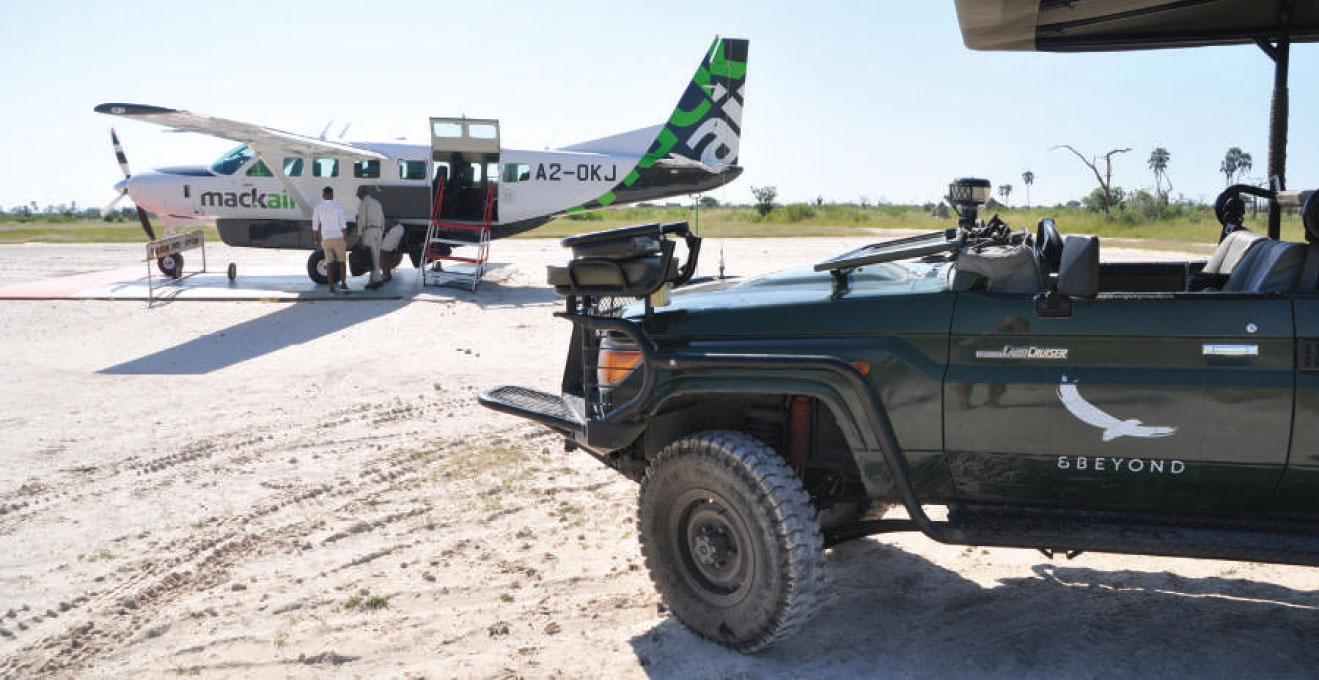
No need for a jet-bridge here! Passengers are often driven directly to the aircraft where they are able to board without fuss or formalities.
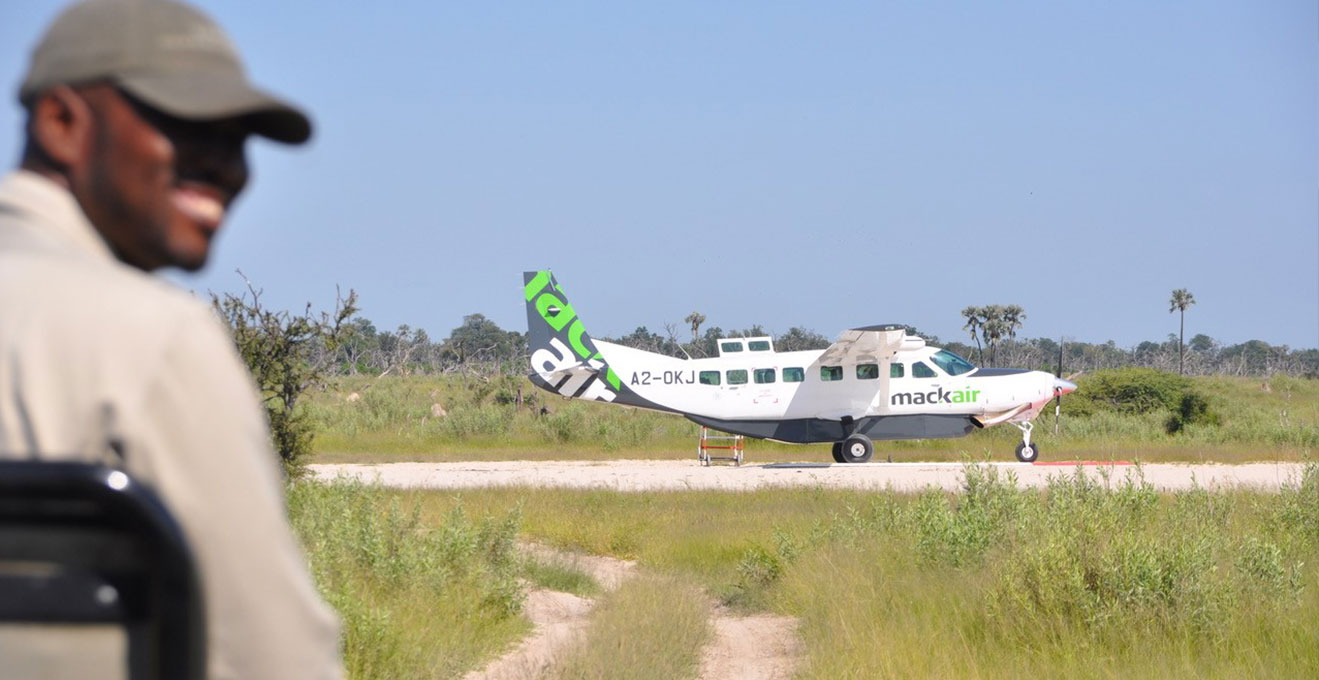
Mack Air is the first private commercial operator in Botswana to hold both scheduled and non-scheduled licenses.
Aviation adventures
“It’s a huge responsibility,” said Steel back at base. “The airstrips are short, there are animals everywhere, with a high number of close calls. Every pilot has their own stories.” It doesn’t take long to realise just how right the young South African is, with everyone soon sharing some truly extraordinary encounters: “I hit a warthog on landing, the gear broke off, but the animal went off into the bush,” recounted Weyl, himself a pilot.
“We’ve had a minor overrun, several bird strikes. We didn’t have any fatalities, but we have had accidents. We had an Airvan that was hit by a zebra as the aircraft came in to land. It appeared from behind and hit the side of the aircraft and the gear broke off. The zebra lay on the runway for an hour and then the guides decided to shoot it, but as they got there with the rifle, the zebra stood up and trotted off into the bush.”
Murdock, with his many flight hours, has his own adventures to share. “When I landed once at Selinda [in northern Botswana], a cheetah wandered across the runway and when I slowed down taxiing, it just walked along, not even running and looking at the propeller. At Nxabegha [a camp northwest of Maun] we had a rhino early last year that for three months didn’t want to leave the runway. That’s a problem, as they don’t leave when you go near them by car, engine running, it thinks this is a challenge and rams the vehicle. That caused some tricky situations!”
Even younger colleagues such as Steel have already had their moments: “A pride of five lions appeared in front of me on short finals, just at the threshold where I was going to land, their tummies were all massive after feeding, so they didn’t want to move. I landed –and it is not a quiet aircraft – but they still didn’t move. They don’t care; they so used to aircraft around here.”
It seems many animals in the delta couldn’t care less about the humans and their time-sensitive airline operations, as Steel recalled: “Ostriches are particularly stubborn, they are notorious for not moving anywhere. Once I had a hyena on the runway that ate its prey and just didn’t want to move. I had to do three go-arounds before it finally decided it had had enough and left. Animals have free rein here, we are just visitors.”
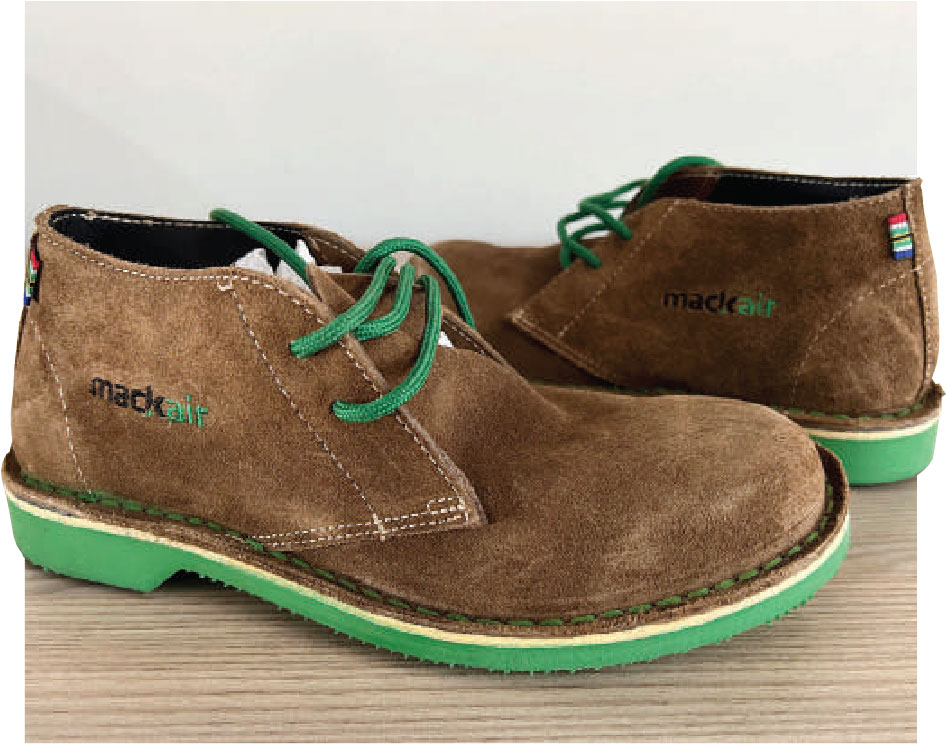
An eye for detail
The airline has cleverly positioned itself as a strong brand with an emphasis on door-to-door service, punctuality, safety, reliability, technical excellence, and a superior cabin product. Nothing you’d immediately expect from a carrier operating in the wilderness in a very remote area in Africa. “But we make a point to extend the high level of excellence the lodges provide to our flights as well,” notes Weyl.
The branding effort goes so far as to put all front-line staff, including pilots, in sleek but casual uniforms bearing the Mack Air name from head to toe, literally. Everyone wears Mack Air caps, shirts, shorts (or long trousers in winter, plus sleek jackets) and yes, even shoes with green soles and stitched-in company name.
“Just branded underwear and socks are missing so far,” jokes Murdock, who takes the liberty to wear his custom-made elephant-leather shoes from Zimbabwe instead.
This attention to detail extends inflight, with passengers not easily forgetting which carrier they are on. They sip from Mack Air labelled water bottles and see the company name stitched on the backs of both pilot-seat headrests on board the Caravans.
This awareness pays off – Mack Air flew 106,478 passengers in 2019 over a total distance of more than 2.3 million miles – the equivalent of nearly ten flights to the moon and back. In total, Mack Air lands at 51 airstrips all over Botswana (not only in the delta), and serves 93 lodges and camps, plus 38 airstrips in Zimbabwe.
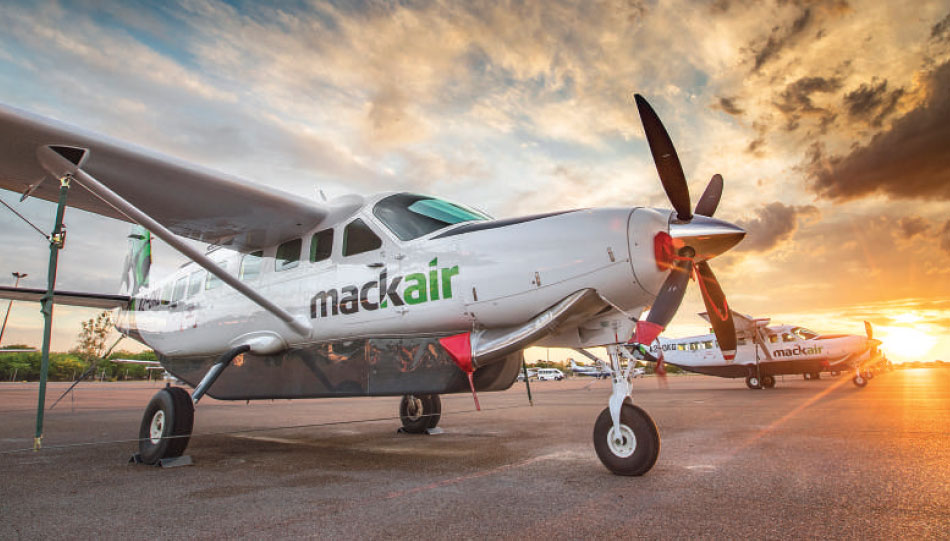
In recent years the airline has overhauled its roster and now boasts the youngest fleet of all the light and medium-sized aircraft
commuter airlines on the African continent
Acknowledgements
The author wishes to thank Michael Weyl and his team at Mack Air (www.mackair.co.bw) for giving him such a close-up insight into its operation. Thanks also to Airlink (www.flyairlink.com) and Linden Birns for providing flight support into Maun. Accommodation was supported by &Beyond (www.andbeyond.com) and Great Plains (www.greatplainsconservation.com).
